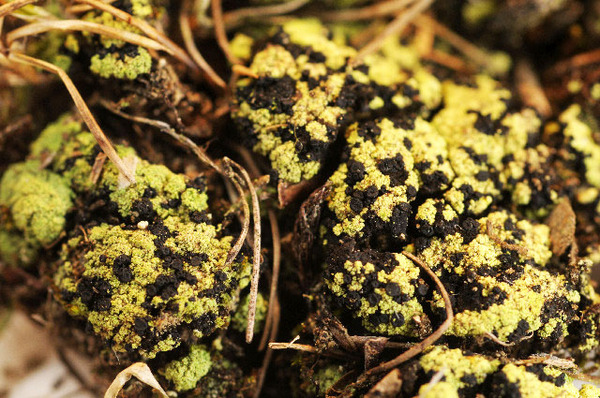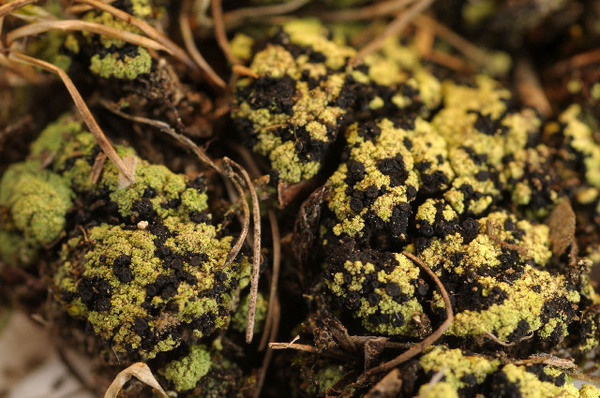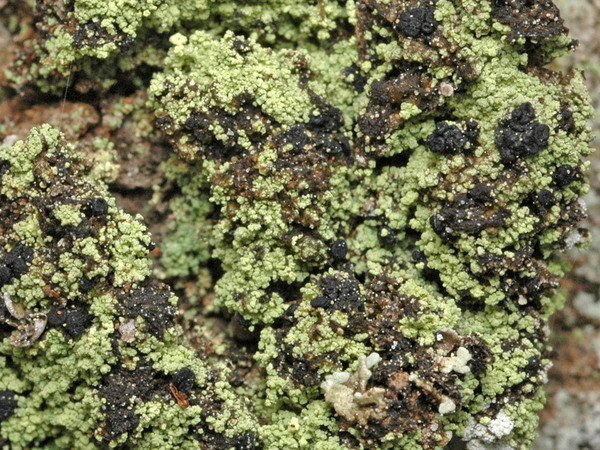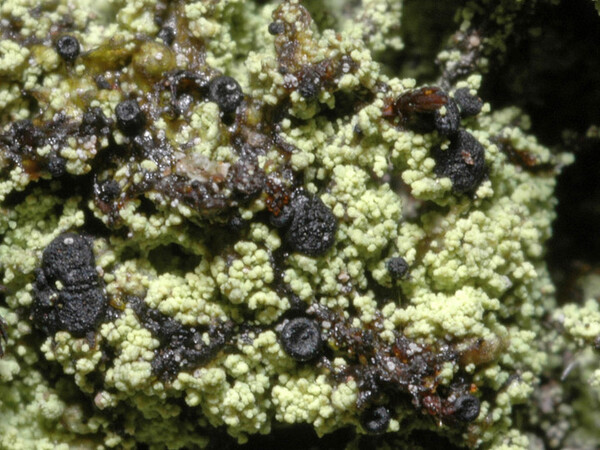Arthrorhaphis citrinella (Ach.) Poelt
Bestimmungsschl. Eur. Flechten: 126, 1969. Basionym: Lichen citrinellus Ach. - K. Vetensk.-Akad. Nya Handl., 16: 135, 1795.
Synonyms: Bacidia citrinella (Ach.) Branth & Rostr.; Bacidia flavovirescens (A. Massal.) Anzi; Bacidia flavovirescens var. citrinella (Ach.) Vain.; Lecanactis citrinella (Ach.) H. Olivier; Lecidea citrinella (Ach.) Ach.; Skolekites citrinellus (Ach.) Norman
Description: Thallus crustose, forming small, irregular, up to 2.5 cm wide patches over saxicolous bryophytes, often dispersed and poorly delimited, greenish-yellow, usually entirely formed of loose, rarely compacted, coralloid aggregations of coarse granular soredia measuring 0.05-0.15(-0.2) mm. Medulla and Ca-oxalate crystals absent. Apothecia lecideine, black, matt, laterally or centrally attached to the granular thallus, more rarely separated from the thallus, single or clustered to 2-8, 0.4-1.0 mm across, adnate to shortly and broadly stipitate, with a flat to distinctly convex, more or less coarsely rugose disc, the margin at first thick and protruding, later level with disc. Proper exciple 55-80 μm wide, dark dirty to brownish olive green, darker towards the outer edge; epithecium brownish olive-green, N+ green, 15-25 μm high; hymenium colourless to pale olive green, densely inspersed with oil droplets, 90-140 μm high; paraphyses sparingly branched and anastomosing, 1-1.5 μm thick; hypothecium brownish olive-green, 50-90 μm high. Asci 8-spored, bitunicate, clavate, I-, scarcely thickened at apex, with a small ocular chamber 100-130 x 10-13 μm. Ascospores (6-)7-11((-15)-septate, hyaline, acicular parallel in the asci, (45-)58-88(-102) x (2-)2.5-3.5(-4) μm. Photobiont chlorococcoid. Spot tests: thallus K-, C-, KC-, P-, UV+ orange. Chemistry: rhizocarpic acid (major), epanorin (minor).
Growth form: Crustose
Substrata: soil, terricolous mosses, and plant debris
Photobiont: green algae other than Trentepohlia
Reproductive strategy: mainly asexual, by soredia, or soredia-like structures (e.g. blastidia)
Commonnes-rarity: (info)
Alpine belt: absent
Subalpine belt: absent
Montane belt: absent
Dry submediterranean belt: absent
Humid submediterranean belt: absent
Padanian area: absent
pH of the substrata:
1 2 3 4 5
Solar irradiation:
1 2 3 4 5
Aridity:
1 2 3 4 5
Eutrophication:
1 2 3 4 5
Poleotolerance:
0 1 2 3
Altitudinal distribution:
1 2 3 4 5 6
Rarity
absent
extremely rare
very rare
rare
rather rare
rather common
common
very common
extremely common
Loading data...
Occurrence data
Predictive map
Growth form: Crustose
Substrata: soil, terricolous mosses, and plant debris
Photobiont: green algae other than Trentepohlia
Reproductive strategy: mainly asexual, by soredia, or soredia-like structures (e.g. blastidia)
Commonnes-rarity: (info)
Alpine belt: absent
Subalpine belt: absent
Montane belt: absent
Dry submediterranean belt: absent
Humid submediterranean belt: absent
Padanian area: absent
pH of the substrata:
| 1 | 2 | 3 | 4 | 5 |
Solar irradiation:
| 1 | 2 | 3 | 4 | 5 |
Aridity:
| 1 | 2 | 3 | 4 | 5 |
Eutrophication:
| 1 | 2 | 3 | 4 | 5 |
Poleotolerance:
| 0 | 1 | 2 | 3 |
Altitudinal distribution:
| 1 | 2 | 3 | 4 | 5 | 6 |
Rarity
absent
extremely rare
very rare
rare
rather rare
rather common
common
very common
extremely common
Loading data...
Occurrence data
Predictive map










